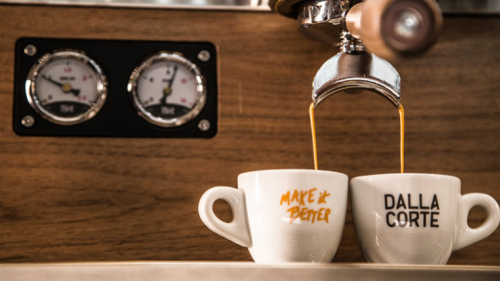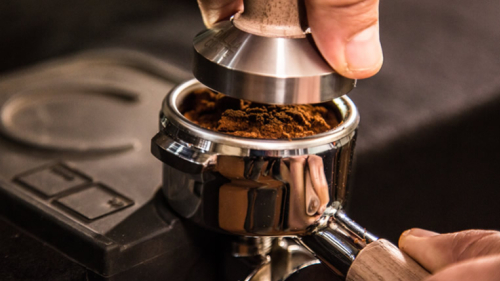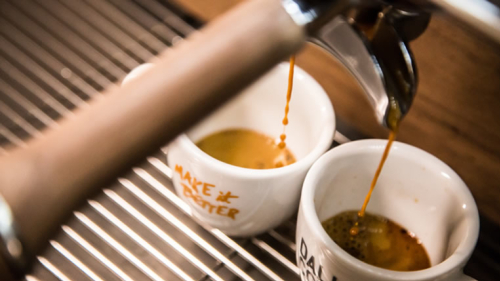Being Your Own Barista
Aug 23, 2021
Chances are, if you love coffee, at one point or another you've thought to yourself, "I wish I had a cafe at home." Maybe the thought occurs while enjoying a lazy morning in bed, or while attempting to wrestle your toddler into a car to accompany you on a caffeine quest, or when wiping up the spillage from a coffee you had delivered to your home. If any of this sounds familiar, know that you aren't alone. Now, with work-from-home the new "norm", and our household members providing the majority of our socialisation, more and more people are opting to create a designated coffee haven in the safety and comfort of their own homes.
So, how does one get started? Setting up a home-based espresso station (mini cafe) can be a daunting experience if you don't have a background in the coffee industry. Here are a few things to consider when taking the plunge and bringing the cafe to you.
1. Budget:
We are all about responsibility at Dalla Corte, so we encourage everyone to plan their budget and purchases responsibly. When creating your budget it's worth noting that if you regularly order takeaway coffees, an at-home set-up will very quickly cover its costs, and in most cases ultimately save you money.
Here's a hypothetical example: A couple spends $10 a day on takeaway coffee ($5 each), which equates to $3,650 AUD a year. If they purchase a Dalla Corte Studio and Max grinder, tamper, and milk pitcher for an estimate of $9,000 AUD (this number will vary depending on the cost of accessories), and spend an average of 60.75 AUD a month on coffee beans and milk for their home espresso bar... it will take them about three years to cover the costs of their investment, after which, they will save an average of $2,921 AUD per year if they continue to drink coffee from home.
Plus - think of all the landfill space you’ll save by not wasting 730+ paper cups and lids per year.
Now, this is a general example, and most people will continue to meet up at a cafe from time to time to have a coffee with a friend, even if they have a home espresso bar, but it's nice to get an idea of just how much one can save when drinking coffee from home.
Also worth noting, a Dalla Corte Studio will easily last 8 to 15 years and perhaps even beyond if it's well maintained.
2. Space:
It seems like a given that you’ll need somewhere to put your espresso machine and grinder once you’ve brought it home. However, you’ll also need somewhere to place your coffee accessories like your tamp, tamp matt, milk pitcher(s), cups and saucers, coffee beans, Knock tube (and used coffee grounds, which can be repurposed in various ways, we make body scrubs out of ours!) and milk.
Additionally, if you choose to purchase a water filter that connects to your espresso machine, you will need space for that to stay as well. Knowing how much space you’ll need, and arranging designated areas for your coffee supplies, will make it that much easier to get started once your machine arrives.
3. Accessories:
On the topic of accessories… if you are purchasing an espresso machine, you will likely need some items to go with it. In addition to a tamper, milk pitcher, and a scale, you may also want to purchase a grinder (Dalla Corte’s grinder Max is an excellent choice for home use.) While you can theoretically purchase pre-ground coffee to use at home, most professionals would advise you to purchase a grinder for home use. This is because, while coffee is constantly changing in flavour from the time it is roasted, once ground, those flavours and aromas that we love tend to vanish infinitely more quickly, leaving you with papery flat tasting coffee in as little as a day after being ground. This is why very dark roasts are so common in the supermarket, that semi-burned flavour tends to mask the flat taste of stale coffee.
There are a number of additional tools you may choose to purchase, but aren’t strictly necessary like, a leveller, a thermometer, and a designated waste bucket for used coffee grounds.
4. Coffee and Milk:
In the above “Budget” section’s hypothetical scenario, the couple spent an average of $60.75 AUD per month on coffee and milk for home use. That number comes from this writer’s personal milk (almond) and coffee (local specialty roaster) preferences. Everyone’s preferences are different, and it’s important to take your preferences into consideration when setting up your own espresso bar.
If you have a favourite cafe that makes coffee just the way YOU like it, it may be worth inquiring who roasts their coffee and whether you can purchase it directly from them or from the roaster in 500g or 1kg bags. Using a good quality coffee ensures that your home coffee experience has the potential to match or exceed your cafe experiences.
On that same note, if you’re used to having “regular” lattes at a cafe, you may not enjoy using lite milk in your coffee at home, or, if you have been drinking almond lattes from a cafe that uses barista quality almond milk, then you may be disappointed using a lower quality plant-based milk at home.
5. Water Quality:
With any coffee machine, the quality of the water you use will affect the taste of your coffee. Hard water will build up within the machine's inner workings and create limescale, which has an unpleasant flavour and can only be removed by descaling your machine. Many people opt to use filtered water in their home-based espresso machines, either by having a filter set-up at their tap, or having a designated filter attached to their machine’s water supply.
6. Education:
Naturally, if you’ve never used an espresso machine before, it would be wise to do a bit of research on how to use one before attempting to use your machine at home.
There are several free youtube videos to help you get started as a barista as well as various online and in-person classes available for those who need more feedback or are hands-on learners.
7. And Finally, The Machine:
While there are ~other~ compact espresso machines on the market, here at Dalla Corte Australia, we are loyal fans of Dalla Corte’s machines. Dalla Corte was the first espresso machine manufacturer in the world to use completely lead free brass, they use materials made from a premium brass alloy that not only improves the machine’s performance, but also doesn't release any heavy metals such as nickel, chromium or lead into the water. Their commitment to social and environmental responsibility is just one of the many reasons we love Dalla Corte.
There are two compact machines available from Dalla Corte, the Studio and the Mina. Both are made to professional standards, with the same high powered steam wands used in the larger commercial Dalla Corte Machines.
The Mina, in a higher budget bracket than the studio, features Dalla Corte’s patented Digital Flow Regulation technology. DFR for short, this technology allows the user to have complete control over the timing and the amount of water that passes through their coffee, all with the ease of a simple app. As any coffee professional could tell you, changing the timing and stages of how water is introduced to coffee will change the texture, taste, and aroma of the coffee. Additionally, different coffee varieties and roasts can benefit from different flow recipes. This feature has made the Mina a popular choice both for individual coffee enthusiasts and small specialty cafes.
The Studio boasts an easy-to-use design, thermal stability, and consistent performance. Its quality and lifespan make it an excellent machine for anyone wanting to create a home-based espresso bar, regardless of whether or not you have prior coffee knowledge and experience. Coffee professionals and first-time users alike have praised the Studio’s consistent performance and ease of use.

Latest news
THIRD WAVE COFFEE: THE NEW ERA OF QUALITY COFFEE
Feb 18, 2025









